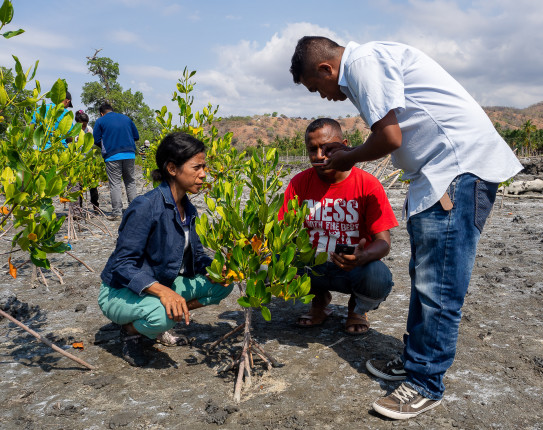-
Nature-based Solutions: Latin America and the Caribbean’s Green Opportunity

Already facing water stress, much of Latin America (such as the western slopes of the Andes and the dry corridor of Central America) is projected to experience intensified periods of drought in the coming decades, further complicating development efforts in the region. At the same time, heavy floods are the most common natural disaster in the region, disrupting life for countless people. According to the World Bank, in Latin America and the Caribbean alone roughly $14 billion per year is required to meet the 2030 water and sanitation targets of the United Nations Sustainable Development Goals. Typically, investments at this scale have been made by governments and large firms that invest in traditional infrastructure such as dams. But with ever-growing development needs and increased understanding of the impacts of climate change, Nature-based Solutions (NBS) are gaining momentum as a new way of incorporating environmental considerations into development responses.
NBS refer to the strategic restoration, protection, or management of ecosystems to intentionally address social challenges. Recent research has shown that combining NBS with traditional infrastructure can be more cost-effective, and result in greater positive side effects for communities.
Investment in NBS—from reforestation to protect water supplies and reduce carbon emissions to natural barriers that protect coastal communities from sea level rise and storm surge—is key to delivering sustainable growth that addresses climate change and its impacts. These investments in infrastructure can also address other pressing environmental challenges, such as lack of water and sanitation, deforestation, ecosystem degradation, and loss of biodiversity.
Examples of NBS in the Latin America and the Caribbean, though insufficient in number and scale, already exist. A forthcoming report from the Inter-American Development Bank (IDB) and the World Resources Institute (WRI) identifies several studies that illustrate the value of NBS. Many of these examples are already well-known locally. In Brazil, for example, “green roofs” in homes of a favela in Rio de Janeiro reduced temperatures in peak heat by up to 20 degrees Celsius, resulting in health and energy-saving benefits. NBS is already providing valuable benefits for flood prevention, as well. In certain places in Latin America and the Caribbean, it is estimated that every 20 km of mangrove forest along coastlines protects an average of over $250 million of infrastructure. In Mexico, coral reefs along the coast of Quintana Roo reduce flood damages by an estimated $42 million annually. Protecting these ecosystems is vastly more cost-effective than building artificial barriers and provides added benefits to local communities, in the form of tourism-related livelihoods and healthier fishing stocks.
Protecting and restoring ecosystems such as forests, wetlands, and floodplains in upper watersheds can improve water quality and availability downstream for agriculture and human consumption, and are necessary for the resilience of critical infrastructure such as hydroelectric power plants.
Other innovative, small-scale nature-based projects, such as planting vetiver grass—a non-invasive plant with a deep root system that can support regrowth of native species—in degraded slopes, can prevent flooding, landslides, and sedimentation while aiding reforestation efforts and supporting livelihoods in local communities. In Trinidad & Tobago, the Pan American Development Foundation (PADF) and local organization IAMovement are using vetiver grass to promote sustainable livelihoods for vulnerable populations. Migrant Indigenous women are learning to make and sell crafts, such as baskets, mats, and chairs, that use vetiver grass as a raw material, illustrating how these solutions also support sustainable development efforts.
Ignoring the role of nature in addressing these complex challenges can come at a high cost. A study of the Amazon basin estimates that a 20-40 percent reduction in forest cover in the Amazon would result in a decline in power generation of the Belo Monte hydropower dam—one of Brazil’s main sources of electricity—to 25 percent its maximum capacity by 2050. Protecting the forest is vastly cheaper than investing in new power generation infrastructure. In a warming planet, and with growing development needs in Latin America and the Caribbean, proactively promoting nature-based solutions, on their own or integrated with existing gray infrastructure, can support the region’s climate mitigation and adaptation efforts.
Our organizations, PADF and WRI, are taking steps to help national and local leaders harness the power of nature for development in Latin America and the Caribbean. Through this partnership, we support research to identify promising NBS throughout the region, raise awareness among investors on the benefits of nature, and connect projects with investors to bring these solutions to the real world. We hope that these efforts, combined with greater ambition by local and international stakeholders from the public, private, and civil society sectors, will bring the region’s vast natural wealth to the forefront of the fight against climate change, benefit local communities, and promote a hemisphere of opportunity for all.
Joaquin Vallejo is PADF’s Senior Program Manager and Environment Practice Area Leader. Prior to PADF, he collaborated with WWF to promote protected areas as natural solutions to climate change in the Amazon region. Joaquin holds a master’s degree in International Environmental Policy from the University of California, San Diego.
Suzanne Ozment is a Senior Associate with WRI’s Cities4Forests Initiative, where she works with governments, financial institutions, companies, and civil society to define pathways for scaling investment in nature-based solutions for climate resilience and as part of a green recovery. Suzanne holds a master’s degree in Environmental Management from the Yale School of the Environment.
Sources: European Commission, Frontiers in Earth Science, International Union for Conservation of Nature, Nature, Proceedings of the National Academy of Sciences of the United States of America, Statista, Vetiver Network, Vimeo, World Bank, World Resources Institute
Photo Credit: Planting mangroves, collecting data, courtesy of Alex Ray/UNDP.
 A Publication of the Stimson Center.
A Publication of the Stimson Center.



